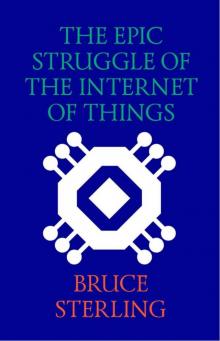- Home
- Bruce Sterling
The Epic Struggle of the Internet of Things
The Epic Struggle of the Internet of Things Read online
1.
The first thing to understand about the “Internet of Things” is that it’s not about Things on the Internet. It’s a code term that powerful stakeholders have settled on for their own purposes.
They like the slogan “Internet of Things” because it sounds peaceable and progressive. It disguises the epic struggle over power, money and influence that is about to ensue. There is genuine internet technology involved in the “Internet of Things”. However, the legacy internet of yesterday is a shrinking part of what is at stake now.
Digital commerce and governance is moving, as fast and hard as it possibly can, into a full-spectrum dominance over whatever used to be analogue. In practice, the Internet of Things means an epic transformation: all-purpose electronic automation through digital surveillance by wireless broadband. In this essay I’ll describe how this is likely to work, and what the major players think they are doing to get there.
To begin, though, I must first free the reader from any folk ideas about the Internet of Things.
So, let’s imagine that the reader has a smartphone in one hand, as most people in the Twenty-Teens most definitely tend to. In the other hand, the reader has some “thing”. Let’s say it’s the handle of his old-fashioned domestic vacuum cleaner, which is a relic of yesterday’s standard consumer economy.
As he cheerfully vacuums his home carpet while also checking his Facebook prompts, because the chore of vacuuming is really boring, the reader naturally thinks: “Why are these two objects in my two hands living in such separate worlds? In my left hand I have my wonderfully advanced phone with Facebook – that’s the “internet”. But in my right hand I have this noisy, old-fashioned, ineffective, analogue “thing”! For my own convenience as a customer and consumer, why can’t the “internet” and this “thing” be combined?
This concept sounds pretty visionary, and it’s certainly enough to impress most people born during the Baby Boom, so this paradigm has been doing well in the popular press. If the reader thinks it over, he can easily refine the basic idea. “This vacuum should be equipped with wireless connectivity and sensors! Also, as its owner, I should have a mobile app or dashboard that can tell me many useful and healthy things about my vacuum – such as how much energy it is using, or how many toxins it found in my carpet. Also, the vacuum should run around in robot fashion, all by itself!”
That’s the standard Internet of Things scenario. It’s framed in the traditional language of consumer electronics. People often mock it, because they don’t like so much unnecessary technical complication in their daily lives. It seems baroque, maybe even fraudulent.
That’s not what’s going to happen.
The real problem with this scenario is that the reader thinks he’s the hero of the story. To the vacuum company, he was the “customer” or “consumer”. In the legacy internet days, he was the “user”. In the Internet of Things, he lacks those privileged positions, “user” and “customer”. An Internet of Things is not a consumer society. It’s a materialised network society. It’s like a Google or Facebook writ large on the landscape.
Google and Facebook don’t have “users” or “customers”. Instead, they have participants under machine surveillance, whose activities are algorithmically combined within Big Data silos. They don’t need the reader to be the hero. He’s not some rational, autonomous, economic actor who decides to encourage the Internet of Things with his purchasing dollars. They’re much better off when those decisions are not his to make.
The reader may be allowed to choose the casing of his smartphone and the brand of his vacuum cleaner, but the digital relation between the two of them is not his decision. He still has a role of sorts, but it’s much like the role he has within Google and Facebook. He gets fantastic services free of charge, and he responds mostly with dropdown menus and checkboxes, while generating data whose uses and values are invisible to him.
The reader didn’t build the phone or the vacuum cleaner. He can’t repair or modify them. He doesn’t understand their technical workings, and when the two of them interact (by various adroit forms of wireless communication), he’s not in charge of that, or of where the data goes. The Internet of Things is not a capitalist marketplace. It’s a new platform for radically broadening digital activity. At the moment, it’s actually many balkanised intranets for digital activity, but it’s called “internet” by the power players, because they aspire to that catholic universality.
The reader is not a “customer” of Facebook because he never paid for Facebook. Facebook’s genuine customers are the marketers – those who pay Facebook for the hard labour of surveilling the billion people on Facebook. Facebook is one of the “Big Five” of Facebook, Amazon, Google, Microsoft and Apple.
None of them are conventional corporations as corporations used to be known. The Big Five all have important central features that previous companies never possessed: an operating system, some dedicated way to sell cultural material (music, movies, books, software), tools for productivity, an advertising business, some means of accessing the internet that they themselves more or less control (tablets, smartphones, phablets), a search engine capability, a social network, a “payment solution” or some similar private bank, a “cloud” capability and, very soon, some dedicated, elite high-speed access that used to be the democratic internet.
The Big Five are the genuine heroes of the Internet of Things. The epic drama of the Internet of Things is really their story. It’s not a popular uprising – except in the sense that the Big Five are really, really “popular” – because billions of people are willingly involved in their systems. The Internet of Things is basically a recognition by other power-players that the methods of the Big Five have won, and that they should be emulated.
The Big Five are smart, profitable, capable and colossal. They are as entirely free of political constraint as the railroads or Standard Oil were in their own heyday. They sense that they can dominate because the enterprises that already dominate are much worse than they are.
Lesser enterprises, and governments as well, have grown bitter and tired of being bossed around by oil companies and bankers in a jobless, terror-riddled World Depression. They see the Internet of Things as a way to break the stasis, attract new investment, and flood the world with yet another tidal wave of cheap, connected silicon. They’re willing to go for this prospect because they don’t see anything else happening. Certainly nothing else with hundreds of billions in potential new wealth, that is.
The standard IoT pitch – about the reader’s smart, chatty refrigerator – is a fairy tale. It’s like the promise of a talking chicken in every pot. Politically speaking, the relationship of the reader to the Internet of Things is not democratic. It’s not even capitalistic. It’s a new thing. It’s digital-feudalism. People in the Internet of Things are like the woolly livestock of a feudal demesne, grazing under the watchful eye of barons in their hilltop Cloud Castles. The peasants never vote for the lords of the Cloud Castles. But they do find them attractive and glamorous. They respect them. They feel a genuine fealty to them. They can’t get along in life without them.
This is not what people expected from “the internet” back when it was a raw, anarchic, electronic frontier. But that was then, this is now. The internet has seen a full generation’s worth of political, economic and social development. The feudal lords of popular mass computation, Microsoft, Apple, Google, Amazon and Facebook, are colossal enterprises today. They can dominate by virtue of their sheer bulk. They are global, gargantuan entities with the power and the revenue to dwarf most national governments.
Much the same goes for their lesser
-known feudal dukes and earls, such as Intel, Cisco, IBM, Samsung – and even their historical enemies, AT&T, Verizon, Comcast, Nokia – as well as the entirety of the Japanese electronics business.
What’s new about this entity called the “Internet of Things” is the demonstrated willingness of entirely alien enterprises to recognise the supremacy of this new power, and swear fealty to it. It’s not much like the scientific, military, anti-commercial “internet” was. Instead, it’s much like a Holy Roman Empire. It’s full of obscure but powerful leagues and consortia, and baronies and dukedoms, and even some Free Cities. It’s about entities like General Electric, which has joined AT&T, Cisco, IBM and Intel in the all-American “Industrial Internet Consortium”. It means the Europeanised “Smart Cities Council” of Mastercard, Bechtel, Alstom, Enel and Qualcomm, an alliance of actors who might seem completely alien to one another, but who suddenly see the chance to conquer whole towns.
These grand, world-scale alliances did not form in order to sell the reader a smart refrigerator. Most of them would really like the reader to dwell in a “Smart City” where they supply the “smartness” on their own terms – and they’re not much concerned about the reader’s consent as a citizen.
The Internet of Things is not about a talking refrigerator, because that is the old-fashioned consumer retail world of electrical white goods. It’s an archaic concept, like software bought in a plastic-wrapped box from a shelf. The genuine Internet of Things wants to invade that refrigerator, measure it, instrument it, monitor any interactions with it; it would cheerfully give away a fridge at cost. Amazon dominates shopping by selling at almost no profit, while deftly seizing digital control of the entire logistics of retail.
Consumer electronics is well understood and easy to promote and publicise, but personal gadgetry is just one battlefield. For the Internet of Things is an across-the-board modernisation effort. It attempts to use the Big Data, network-centric methods pioneered by Apple, Microsoft, Facebook, Google and Amazon, to seize control over as much of the planet’s industrial terrain as possible. That means power grids, water systems, transport systems, police networks, fire and disaster-response networks, heating, air conditioning, factory production, storage and logistics. Basically: anything with a barcode, a knob, a lever, a faucet, a dial or an off-switch. They want it all. They want to become modernity.
That doesn’t mean that the Internet of Things will triumph, because, in some ways, it can’t win. It’s too broad and vague to win; it’s a huge, looming infrastructural phenomenon, much like “electrification” or “automation” once were. People never voted to become electrical or automated. Those processes came from a rough consensus among the political and managerial classes of the developed nations: “we must electrify, we must automate”. Those who disagreed were reduced to the state of the Amish; they were just routed-around.
The Internet of Things doesn’t want to electrify or automate because that work, for better or worse, is mostly done now. Basically, it wants to “electronically automate through digital surveillance by wireless broadband”. There’s a pretty good chance that a civilisation that went for 1 and 2 will be willing to go for 3. It might even exult in it, take pleasure in it, embrace the Internet of Things and take it to its heart.
The IoT (as its friends like to call it) has one distinct advantage: everyone already has a smartphone in their hands. The smartphone is the basic pass-ticket, the voucher, the proof of existence. The smartphone is the Thing in our modern world that is the most Internetted of our Things. Once the reader has one of those in his pocket or her purse, she is assimilated. And the reader has one.
So does everybody else. All of the great and the good of the planet: bankers, senators, regulators, venture capitalists, engineers, designers, coders, the military, the church, the academy – every last one of them has a wireless broadband lozenge that’s chock-full of responsive sensors and sophisticated electronics. There is no power-group of consequence in the world today that successfully renounces smartphones. No one who matters refuses what they offer.
The smartphone business was the fastest trillion-dollar business in human history. It was faster and stronger and much more popular than its predecessors, the mainframe, the desktop, the laptop. All one has to do, from that grand perspective, is to forget about the talking fridge. Instead, imagine an Android or iPhone unbundled into its tiny component parts and scattered across the whole world.
That would mean that every “thing” would rejoice in some fraction, larger or smaller, of the many, many powers inherent in a smartphone. This is a Manifest Destiny for silicon.
There’s a certain engineer’s lucidity in this techno-paradigm: yes, in its preordained shrinkage, the smartphone might pause a little while at “wearables”, at wireless-broadband consumer-friendly form-factors like bracelets, shoes, earrings, spectacles, Bluetooth ear adornments and so on. However, the logical endpoint must be planetary “smart dust”. It means full-service computers, with radios, that can fit within the printed letter “o”. It’s a lower-case, fine-print internet of microscopic things. Connected things so cheap and plentiful that we treat them like incense or holy water.
For Internet of Things zealots, this vision is what energy-too-cheap-to-meter is for nuclear zealots. It’s like the vision of a flying car in every garage, back in the visionary days of aviation and mass-production lines. In other words, it’s a utopian vision of technological determinism. If we’ve learned anything from a generation’s marriage to the internet, we should know that that’s not how things work out in real life.
The Internet of Things is not like the internet, which was an unplanned and spontaneous advent with a certain off-the-wall, sprightly and vividly manic quality. The Twenty-Teens are not the Nineteen-Nineties; politically, economically and socially, the Twenty-Teens are a Depression. The internet brought many laudable things, but prosperity, stability, accountability and honest politics were not four of them.
The Internet of Things has a slight utopian tinge, but mostly it has a certain melancholy, even grim air. It’s not some psychedelic exploration of the cyberspace of the digital. It’s material labour, it’s hardware, it’s a hard slog. The Internet of Things has already been tried once, and it failed.
The original, failed “Internet of Things” was based around the invention of the Radio Frequency ID chip. Its grand champions were Wal-Mart and the Pentagon. The great American retailer of Chinese-made goods and the US military-industrial complex united to impose electronic barcodes on the host of “things” they bought or commissioned.
This premature, imperial effort was stunted for a number of painful, complex reasons. The main failure was political. The RFID Internet of Things failed through the overweening arrogance of Wal-Mart and the Pentagon in thinking they could get away with it, simply impose a technology by fiat. They thought that they could paste little interactive radios onto everything that mattered, and that no other power-player would catch onto their hack of the infrastructure.
The suspicious Chinese immediately said no, which blew away much of Wal-Mart’s interest. The Pentagon’s electronic presence in world manufacturing and shipping was about as popular as the NSA’s is right now. The Pentagon is the ultimate sucker consumer: they’ll blindly pay any sum for anything, and its military contractors like the process kept that way.
As for the general populace, there seemed to be nothing for them in the elite and secretive world of electronic barcodes. Whenever mere civilians expressed some interest in RFID and “auto-identification”, they were insulted, dismissed or fed a pack of childish lies by hired PR firms. The first Internet of Things revolution was hugely ambitious, arrogant, intrusive, fundamentally dishonest, and a failure; so much so that the new IoT movement carries on as if there had never been one at all.
Despite selling memory by the bucket-full, the computer business has a very short memory, and the new IoT is back a mere decade later – this time with bigger coalitions, more political support, and ra
dically upgraded hardware and software. But it’s still an epic struggle, and it could still fail again.
It’s clear that today’s Internet of Things isn’t just a techno-revolution; it’s a reaction. It’s not by and for the oppressed, the disruptive, the hungry, the have-nots, the start-ups, the shut-outs. The Internet of Things is very much in the interests of certain groups who can already count themselves among the haves. Many of its architects are clearly inspired by fear – they’re powerful, but afraid to lose the things they already command and control. By intensifying their command and control systems, they hope to maintain their hold.
The Chinese are happy to call their own strange activities the Internet of Things too. If it ever exists, the Chinese IoT will likely be much better known as the “Firewalled Internet of Heavily Censored Things with Chinese Characteristics”. The Chinese know that this blanket of techno-affirmation, the Internet of Things, requires no Western shibboleths of civil rights or individual autonomy. It’ll work for them just as well as it works for anybody, and maybe better.
It gets worse. Due to its louche, unruly internet heritage, the Internet of Things is already infested with spies and thieves. They’re not minor threats either, but colossally powerful, nationally financed spies, along with persistent, vicious, clever, socially networked, high-tech thieves.
The internet, although beloved by all including Al Qaeda, went straight from barbarism to decadence without ever encountering a civilisation. It was never utopian, although it was free. Its lawyers are patent trolls. Its political parties are flash mobs in the streets. Its wealthy are nouveau-rich cranks. Its poor are a tidal wave of Third World young people. The Twenty-Teens are quite an interesting cultural period.
The Internet of Things makes no attempt to redress, or even address, the many real problems that the internet brought to the world. On the contrary, it’s an international effort to bring everything that wasn’t internet within the purview of the techno-elite that currently dominates the internet.

 Mirrorshades: The Cyberpunk Anthology
Mirrorshades: The Cyberpunk Anthology The Wonderful Power of Storytelling
The Wonderful Power of Storytelling Love Is Strange (A Paranormal Romance)
Love Is Strange (A Paranormal Romance) Globalhead
Globalhead Essays. FSF Columns
Essays. FSF Columns The Hacker Crackdown
The Hacker Crackdown Bicycle Repairman
Bicycle Repairman Black Swan
Black Swan Crystal Express
Crystal Express Islands in the Net
Islands in the Net Pirate Utopia
Pirate Utopia GURPS' LABOUR LOST
GURPS' LABOUR LOST The Dead Media Notebook
The Dead Media Notebook Unstable Networks
Unstable Networks The Manifesto of January 3, 2000
The Manifesto of January 3, 2000 Heavy Weather
Heavy Weather Involution Ocean
Involution Ocean The Epic Struggle of the Internet of Things
The Epic Struggle of the Internet of Things A Good Old-Fashioned Future
A Good Old-Fashioned Future The Littlest Jackal
The Littlest Jackal Zeitgeist
Zeitgeist Totem Poles
Totem Poles Ascendancies
Ascendancies CyberView 1991
CyberView 1991 War Is Virtual Hell
War Is Virtual Hell Taklamakan
Taklamakan Holy Fire
Holy Fire Cyberpunk in the Nineties
Cyberpunk in the Nineties Schismatrix Plus
Schismatrix Plus The Artificial Kid
The Artificial Kid Essays. Catscan Columns
Essays. Catscan Columns Maneki Neko
Maneki Neko Distraction
Distraction In Paradise
In Paradise Red Star, Winter Orbit
Red Star, Winter Orbit Luciferase
Luciferase